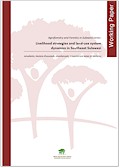| Working Paper Series |
 |
|
| Title | Agroforestry and Forestry in Sulawesi series: Livelihood strategies and land use system dynamics in Southeast Sulawesi | | Author | Janudianto, Noviana Khususiyah, Isnurdiansyah, S. Suyanto and James M Roshetko | | Year | 2012 | | Publisher | World Agroforestry Centre (ICRAF) Southeast Asia Regional Program | | City of Publication | Bogor, Indonesia | | Series Number | Working paper 156 | | Number of Pages | 53 | | Call Number | WP0168-13 | | Keywords | AgFor Sulawesi Project, Southeast Sulawesi, land-use dynamics, livelihoods, income,
local farmers, migrant farmers, cacao agroforestry |
|
| Abstract: |
The project, Agroforestry and Forestry in Sulawesi: Linking Knowledge with Action (the ‘AgFor
Sulawesi Project’) has been developed for implementation in 3 provinces of the island of Sulawesi,
Indonesia (South Sulawesi, Southeast Sulawesi and Gorontalo) from 2011 until 2016 to enhance the
agroforestry and forestry livelihood systems of rural communities in Sulawesi. This baseline survey
was conducted to support the project. The main objectives of the survey were to study the general
characteristics of community livelihoods in Southeast Sulawesi, local farming systems and current
land-use systems based on community perspectives. Assessment of land-use dynamics, farming
systems and livelihood strategies within 2 districts in Southeast Sulawesi is very important for
developing the next phase of the project. Two unit analyses were used in the livelihood baseline
study— community and household levels.
The group discussion results in the 4 village typologies showed that there were small differences in
livelihood options within the villages, which mainly earned income from cacao cultivation. However,
in terms of tree crops and farm management, differences were clear. In typology 1 (local villages), the
main crops were cacao, paddy, patchouli and sago. Typology 2 (local and migrant villages) opted for
cacao, maize and paddy rice, while typology 3 (long-established transmigrant villages) farmed cacao
and pepper. Typology 4 (recent-established transmigrant villages) inhabited was different as charcoal,
timber and fruits were preferred besides cacao. The farm management systems of immigrants from
South Sulawesi were more intense than the indigenous population. The cacao system used by locals in
typology 1 was not intense compared to those managed by immigrants from South Sulawesi in
Typology 2. In all 4 villages, the cacao agroforestry area has increased tremendously during the last
40 years, accompanied by a significant decrease in forested area generally.
The household survey concluded that the average total income per year per household in typology 1
villages was lower than their counterparts from elsewhere. The daily per capita income of farmers in
typology 1 villages was also lower than other farmers who were earning considerably more from other
sources. |
|
|
Download file(s): Click icon to download/open file.
|
| |
File Size |
Description |

|
2,887 KB |
Softcopy |
|
|
|
| Viewed in 2348 times. Downloaded in 461 times. |